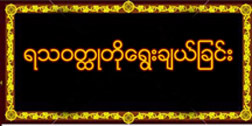Buddhist Psychotherapy
ME26 19-03-2011 (4:00 to 5:00)
(Class Notes Only)
-----------------
The Vipassanā(Pañña) meditation research into the application of Vipassana in daily life. The Enlightened One wandered from place to place, teaching the Dhamma in villages and towns out of infinite love and compassion. The Buddha taught a practical method to help mankind escape from the bonds of suffering: the Eightfold Noble Path (Ekāyano ayaṃmaggo).He's theme was the same: sīla (morality), samādhi control of the mind (samatha), and pañña (purification of the mind by wisdom). He declared: Dhamma is universal. Dhamma is the law of nature. He taught that every person must discover for himself what is conducive to his own good and welfare, and the good and welfare of others. He gave to humanity its first charter of freedom, gave the possibility of a way out. The door to freedom opened. To practice insight meditation in accordance with the four foundations of mindfulness is the only way to purify the mind of practitioners. It leads them to the cessation of suffering and the attainment of Nibbana. Practitioners must first purify their Silas. The Silas build concentration (Samadhi) easily, then insight knowledge arises seeing Rūpa (corporeality or nature of bodies) and Nāma (mind or mentality) as they really are. It should be known that the meditator can discern Rūpa and has entered Rupapariccheda- ñana.
In the early teaching of the Buddha, the empirical word is analyzed, as clearly stated in the Khandhavagga Samyutta, is based on the truths of :
rūpa (physical phenomenon),
vedanā (feeling),
saññā (perception),
saṅkhāra (mental fashionings)
viññāna (consciousness).
These five groups of existence, life’s basic factors. While rūpa refers to the physical reality and the other four groups refer to the mental reality. While the meditator is being mindful of his hand, his foot stretching or bending, his body dropping to sit down or supporting his body to stand up, these features of movement arise from many small combined movements. Buddhist morality distinguishes healthy, right and moral actions from those that are unhealthy, wrong and immoral action. In the Pali canon, we find many moral concepts which play an important role in the moral life of a Buddhist even today.
The terms Kusala (wholesome) and puñña (merit) are the most important of these. These Kusala actions lead to nirvāṇa, Akusala (unwholesome) actions make one deviate from the path of liberation. The Buddha once said that one becomes endowed with right vision (sammā diṭṭhi) through the knowledge of both wholesome and unwholesome actions and their roots. He recommends the wiping out of akusala through kusala ones, since such eradication brings happiness.
Buddhism recommendes the five precepts (pañca sila) for lay Buddhists and other morally higher precepts for monks, all these moral virtues, in one way or another. The five precepts, for example are common to many religious traditions.Since Buddhism recognizes the worth of all living beings, Buddhist precepts include all livings beings withing their scope.
When one practices the meditation on living kindness (mettā), one has to develop loving kindness to all beings (sabbē sattā bhavantu sukhitattā). In the Metta Sutta of the Suttanipāta this universal loving kindness is highlighted as follows: may all beings be happy and secure; may their minds be contented etc,. Let one’s thoughts of boundless love pervade trained in sīla, one is in a good position to train one’s mind (citta).
The second stage is samādhi (concentration) which includes three components: right effort (sammā vāyāma). Right mindfulness (sammāsati) and right concentration (sammā samādhi).These three elements train one’s mind to a state of samādhi. The third stage of the gradual path is wisdom (pañña) which includes right view (sammā diṭtṭhi) and right thoughts (sammā saṃkappa). Wisdom enables one to see reality as it is (yathābhūta). Wisdom arises only in a concentrated mind (samādhi citta). Thus, through a gradual process of training (anupubbasikkhā), working out (anupubbakiriyā), and practice (anupubbapaṭipadā), the spiritual seeker reaches moral perfection. On one occasion, the Buddha explains how morality leads one to nirvāṇa.
In this case the the spiritual path in this world and the ultimate goal are interconnected and interrelated within the process of leading the spiritual seeker to moral perfection. It is important to examine the way Buddhism explains the relatioship between moral actions and the nature of the internal mental process. Early Buddhism offers a causal and psychologycal analysis both of the external behavior of the individual and of his or her internal dispositions.
Buddhism views immoral actions such as stealing (adinnādāna), killing (pāṇātipāta), lying (musāvāda),etc., the unwholesome (akusala) actions are mentioned in the sutta as follows: Physical (body) is Killing living beings , stealing others things and unlawful engagement in sensual pleasures, Verbal is Lying, slandering, using rough words and gossiping, and Mental is Greediness, malevolence and holding wrong views. These are related to the physical, verbal and mental behavior of people.
Anusayas which can be eliminated through wisdom, exist until one attains enlightement, Through wisdom. At the time of enlightenment one achieves internal purification and intergration of one’s internal dispositions with physical actions. The relationship between morality and wisdom is another important aspect of Budhism. The Buddha points out that morality and wisdom are interrelated and mutually activate each other.
by Ashin Indaka (Kyone Pyaw)




























0 comments:
Post a Comment